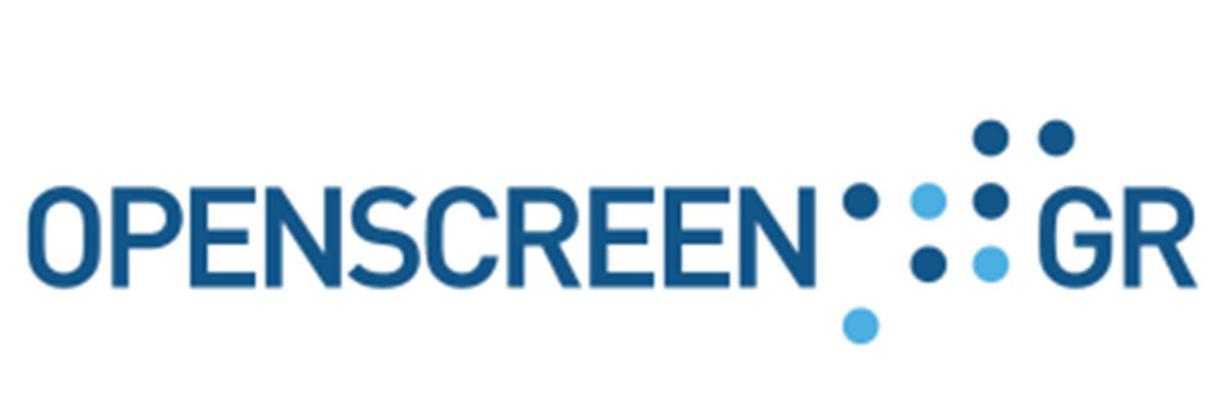National Hellenic Research Foundation
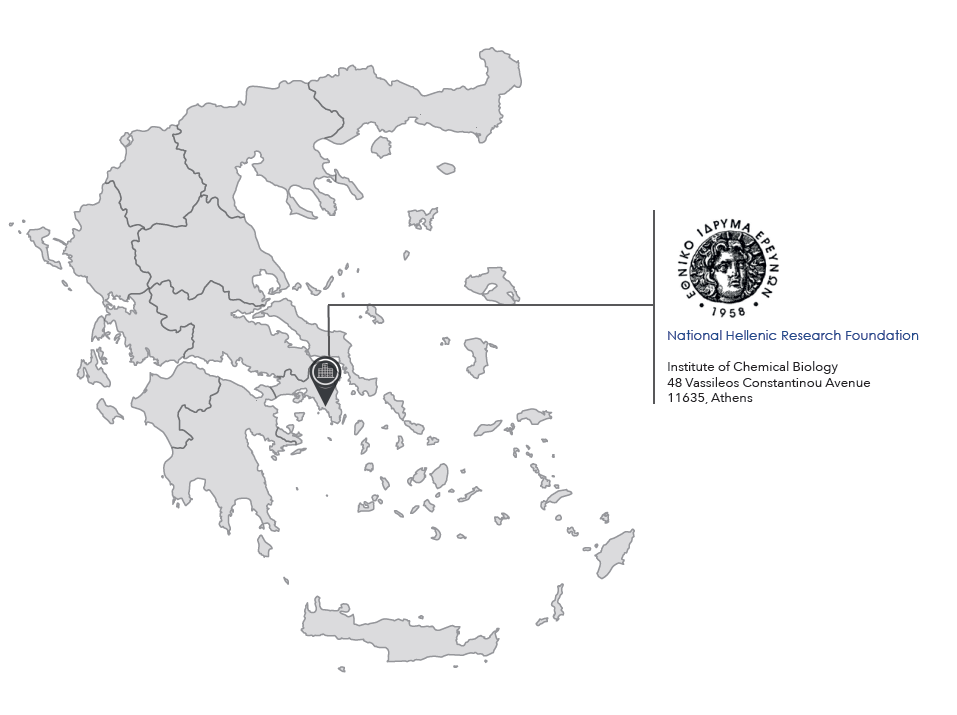
The Institute of Chemical Biology (ICB) of the National Research Foundation (http://www.eie.gr/nhrf/institutes/ibmcb/index-gr_ibmcb.html) operates as a unique pole of innovation in Greece. ICB is active in the field of Chemistry and Biology and implements a comprehensive and modern research approach to solving cutting-edge issues in the fields of health, medicine and biotechnology. The goal of ICB is to address contemporary challenges with a national, national and global dimension. ICB’s excellence development goals include:
- Development of new bioactive compounds of potential (targeted) drugs, molecular probes (smart probes) and therapeutic. The ICB approach encompasses the whole spectrum of drug development up to preclinical screening, with the aim of preventing, diagnosing and treating degenerative conditions and diseases.
- Promotion and validation of biomarkers of risk assessment, prognosis and diagnosis of diseases and predictive biomarkers of response to (targeted) therapies, utilizing holistic approaches.
- Basic research to highlight the molecular mechanisms involved in physiological and pathological conditions.
- Development and utilization of methods of Biotechnology, Synthetic Biology and Green Chemistry with the aim of producing products of high added value with applications in food, medicine, cosmetics and chemicals.
- Promotion of translation research through closer collaboration with clinical scientists.
- Consolidation of IXB activities in the academic and research education of young scientists and enhancing the diffusion of scientific knowledge in society.
- Strengthening partnerships with the private sector, transfer of know-how and provision of specialized research services in the public and private sector.
- Utilization of research results through patents and creation of spin-off companies.
Furthermore, our services include: Optimization of hit compounds for biological targets of users’ interest. In the context of discovery and development of new drugs, an important step is the optimization of the initially characterized bioactive compounds for a specific purpose, which usually do not have the required activity or the structural characteristics that make them suitable for their further development as possible drugs. .
Our collaboration with OPENSCREEN-GRresearch infrastructure offers new optimized analogs through synthetic modifications of the original structures. The process is feedback-based and allows only compounds with the desired biological profile to be selected for preclinical fitness testing, thus saving resources.
Hits’ modifications are guided by the in silico interaction with the biological target as well as by calculating the ADME-Tox properties. The bioisosteric substitution strategy is also used for the hit to lead optimization (H2L) process. Modern methods of organic synthesis, high energy techniques (microwaves, ultrasound) as well as parallel synthesis are used. The infrastructure provides the ability to synthesize on a scale of many grams of active analogues.
Services

Fully Equipped Modern Laboratories for Synthesis
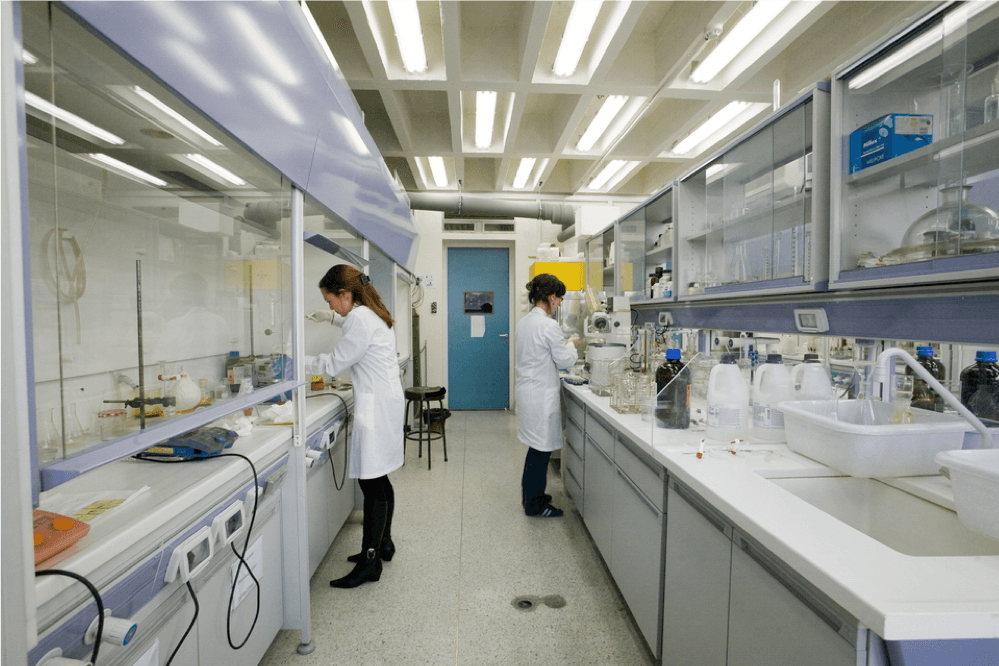
Microwave Device for Synthesis
Equipment
CEM Discover
Characteristics
- 10-mL sealed pressure vessels Temperature control with infrared thermometer regardless of volume.
- Ability to stir.
- Ability to carry out reactions in an open container
Applications
- Synthetic organic chemistry, presence or absence of solvent.
- Carrying out reactions at temperatures higher than the boiling point of the solvent under pressure with the effect of microwave radiation.
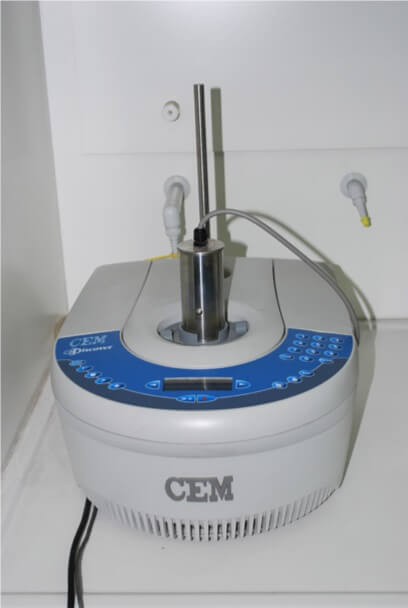
Continuous Flow Hydrogenation and Deuteration Reaction Device
Equipment
Thales Nano H-Cube Mini Plus
Characteristics
- Production of hydrogen or deuterium gas internally by electrolysis
- Operation in temperature range from ambient temperature (RT) up to 100 ° C and in pressure range from 1 bar to 100 bar.
- Accepts prepaid columns with a variety of catalysts
Applications
- Hydrogenation and deuteration reactions of organic molecules in continuous flow.
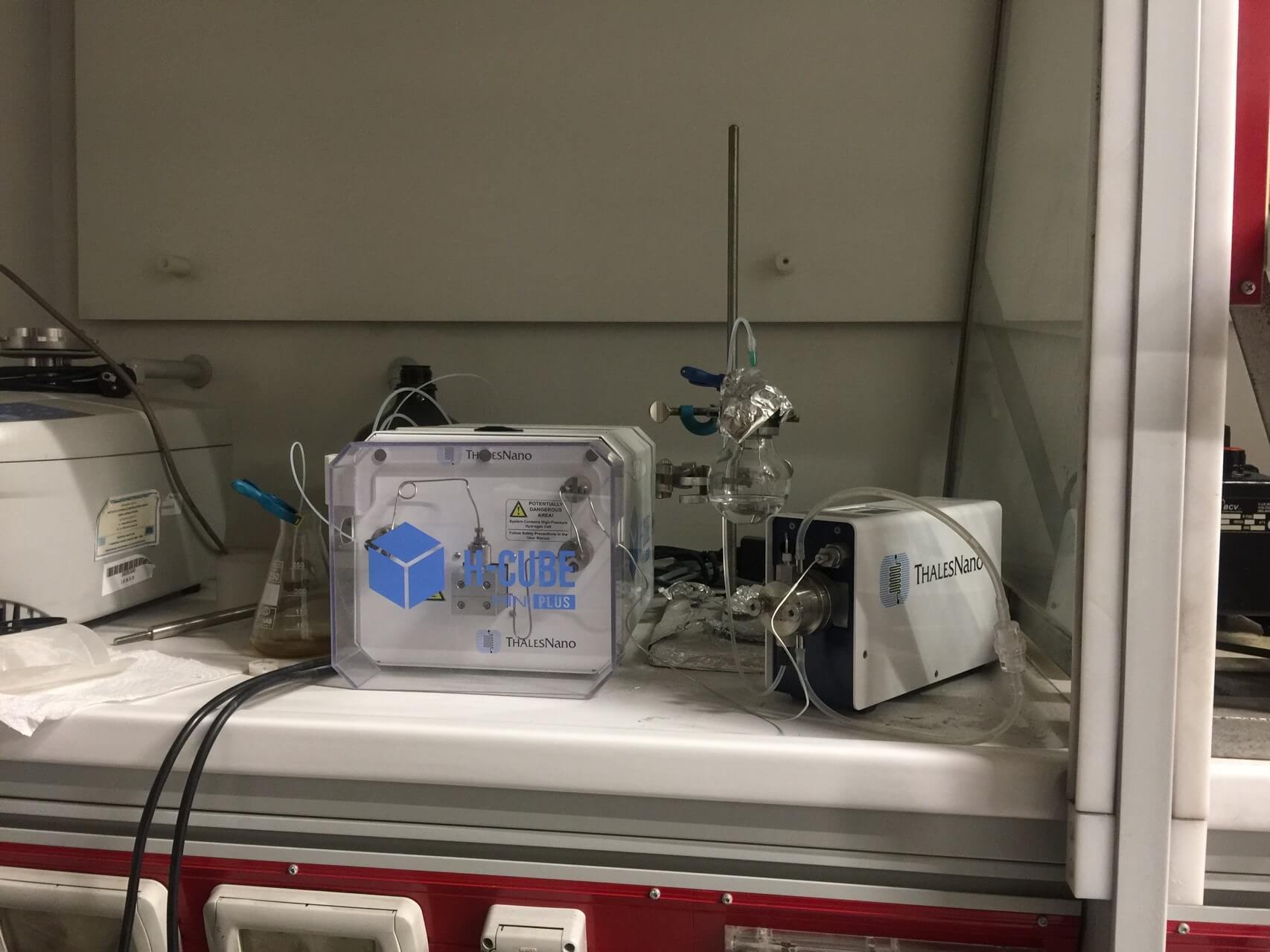
System for Parallel Synthesis
Equipment
Buchi Syncore Platform
Characteristics
- Parallel composition in liquid and solid phase.
- Includes shaking.
- Includes a 24-seat platform.
- Operation in temperature range from -20 ° C to 150 ° C
- Simultaneous condensation.
Applications
- Carry out parallel reactions for optimization and / or for the preparation of library compounds for obtaining activity structure relationships.
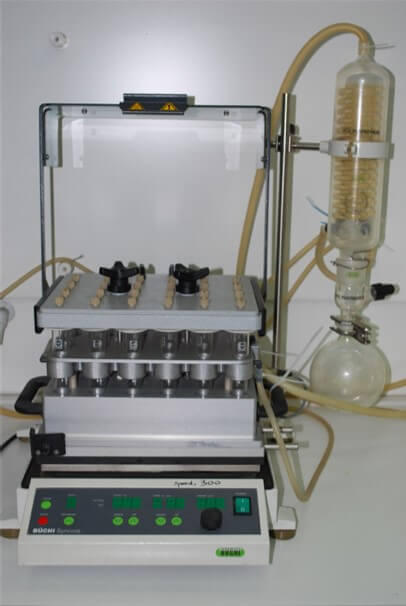
System for Larger Scale Synthesis
Equipment
Radleys Reactor-Ready ™ Lab Reactor
Characteristics
- Includes 5L double-walled glass reactor.
- Includes digital mechanical stirrer with the ability to stir samples with a maximum water volume of 50 L, a maximum viscosity of 100,000 mPa and with the ability to rotate at a maximum of 2000 rpm and with a maximum torque of 200 Ncm.
- Operation at temperatures from (-70 ° C) to +230 ° C.
Applications
- Carrying out large-scale reactions.
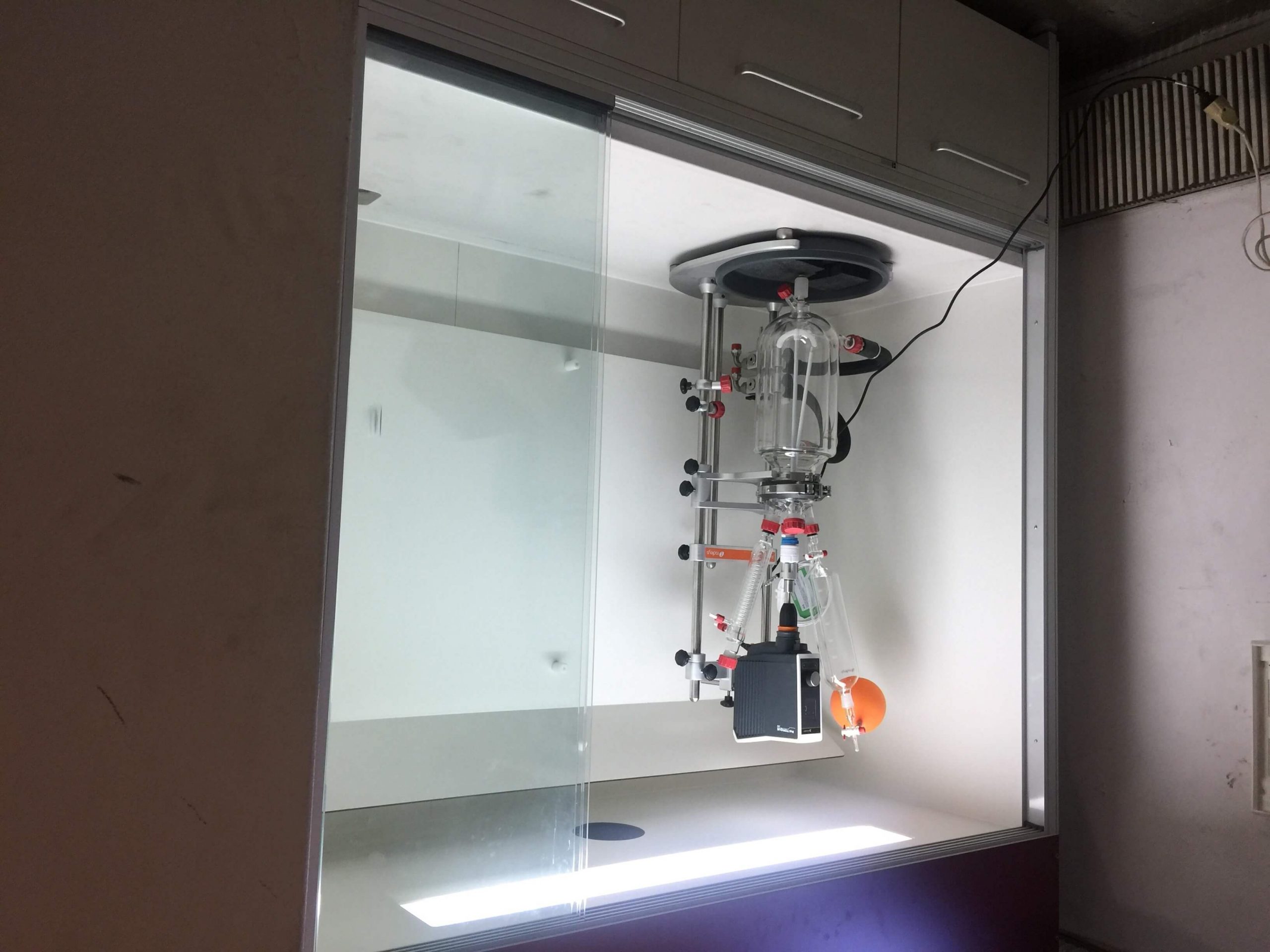

Polarimeter
Equipment
Kruss Optronics P3000
Characteristics
- The polarimeter is automatic and digital.
- Ensures measurement accuracy ± 0.01 °.
- Performs measurements in time ≤ 1.1 s.
- Has a measuring range in units of angle [°, ° Z] from ± 90 ° to ± 259 ° Z with a resolution of ± 0.01 ° Z.
- It has an accuracy better than ± 0.02˚ Z throughout the measuring range. • It has a repeatability of 0.01o, 0.01 ° Z.
- It has an LED light source with a filter.
- It has a sensitivity of 0.1% (OD3).
Applications
- Measurement of the optical angle of rotation of chiral joints
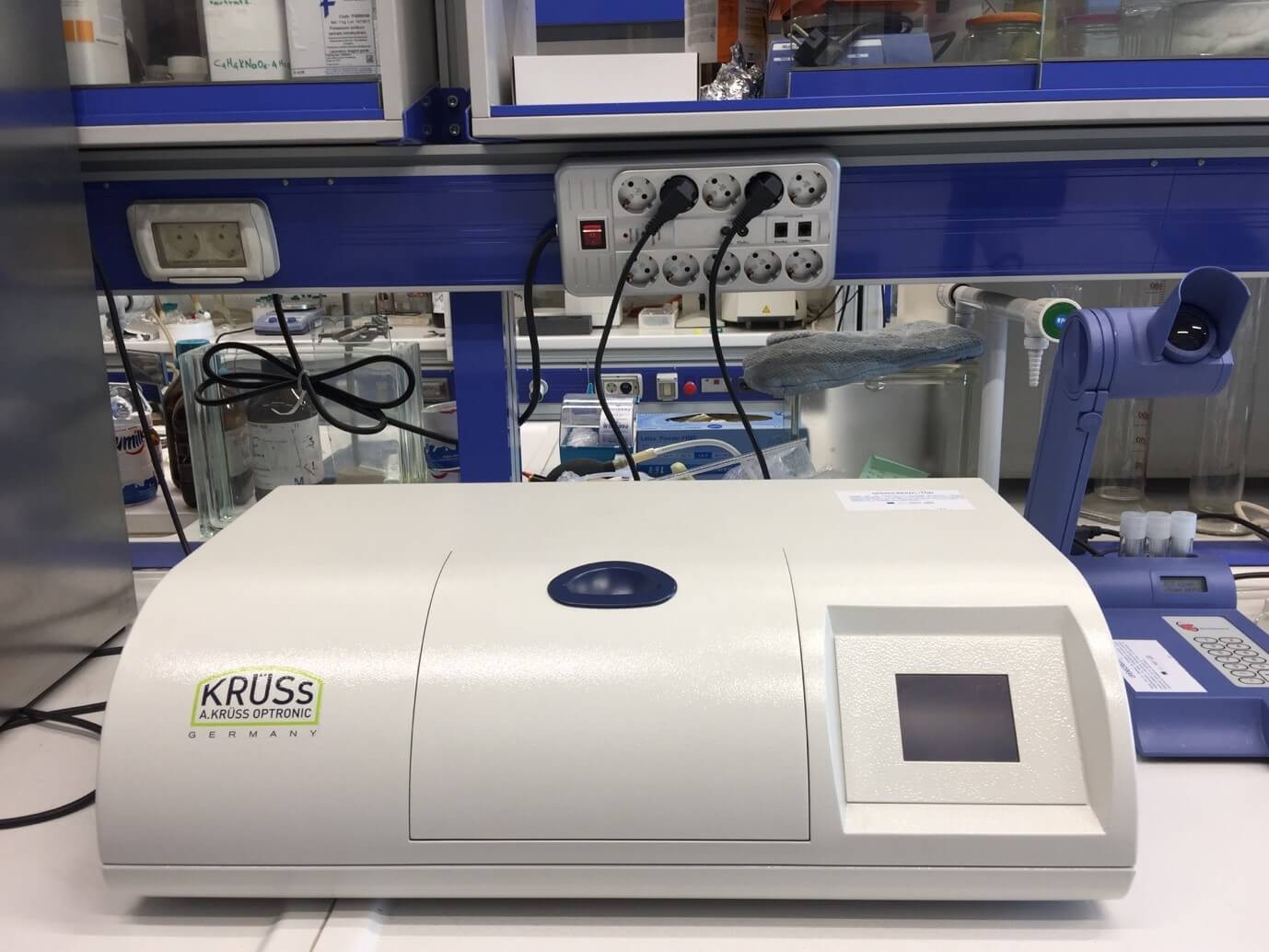
Nuclear Magnetic Resonance Spectrometers
Equipment A
NMR 600 MHz Varian Spectrometer
Characteristics
Magnet
14.1 Tesla 54 mm bore Varian Superconducting Magnet
- Console:
DIRECT DRIVE ARCHITECTURE INCLUDING POWER PC AND XILINX FPGA. - Provides total pulse programming control and delivers precisely timed RF events.
- Complete waveform shaping capability.
- 3 RF Channels
- Channel 1 is highband, with 1H/19F observe, spinlock and decouple capability (550-600 MHz, 50W)
- Channels 2 & 3 have broadband observe, spinlock and decouple capability (18-245 MHz, 300 W)
- Performa IV Pulsed Field Gradient Module
- Protune Accessory
- Variable Temperature unit (-150C to +250C, with 0.1C resolution)
- Probes:
1H{13C/15N} 5mm PFG Automatable Triple Resonance
• 1 H{15N- 31P} 5 mm PFG AutoX Indirect Detect 600
• 1 H-19F/15N- 31P 5mm PFG AutoX DB600
• 4mm Nanoprobe (gHX 8 15W- 31P[1H] )
Host computer: Dell 380N PC, Red Hat Linux
Software: VNMRJ 2.2C
Applications
- Characterization of the structure of organic compounds
- DOSY experiments for separation of mixture components
• Triple coordination experiments of chemical compounds and biomolecules.
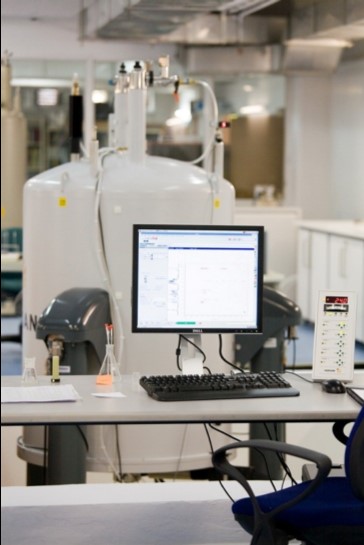
Equipment B
Spectrometer NMR 300 MHz Varian
Characteristics
Magnet:
7 Tesla 52 mm bore Oxford Magnet
Console:
DIRECT DRIVE ARCHITECTURE INCLUDING POWER PC AND XILINX FPGA.
- Provides total pulse programming control and delivers precisely timed RF events. Complete waveform shaping capability.
- Channel 1 is highband, with 1H/19F observe, spinlock and decouple capability (200-300 MHz, 50W)
- Channels 2 has broadband observe, spinlock and decouple capability (12-220 MHz, 300 W and 220-245 MHz, 150 W)
- Performa I Pulsed Field Gradient Module
- Carousel autosampler for 9 samples
- Variable Temperature unit (-15oC to +25oC, with 0.1oC resolution)
Probes: 1 H/19F/31P/13C 5mm PFG AutoSwitchable
Host computer: Dell 380N PC, Red Hat Linux
Software: VNMRJ 2.2C
Applications
- Single and double coordination studies for the complete characterization of the structure of organic compounds.
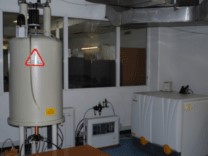
Mass Spectrometers
Equipment
UHPLC – LTQ Orbitrap Velos, Thermo Scientific
Characteristics
- Ultra High Pressure Liquid Chromatography Mass Spectrometer
Mass Accuracy and Ultra High Resolution - The LTQ Orbitrap Velos combines the proven mass accuracy and ultra-high resolution of the Orbitrap mass analyzer with the increased sensitivity and improved cycle time of the LTQ Velos to deliver high-performance
- Hybrid FT Mass Spectrometer.
- Accela LC System
- Heated Electrospray Ionization Probe (H- ESI II Probe)
- APCI Probe
- Unique dual-pressure trap technology
- New higher-energy collisional dissociation (HCD) cell
- Orbitrap mass analyzer
Applications
- Discovery and development of drugs • Metabolics
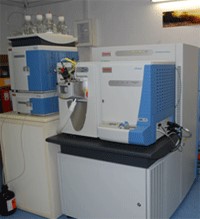
Equipment
HPLC-LCQ Fleet / Thermo Scientific
Characteristics
- Surveyor LC System
Ion MAX ESI probe
APCI Probe for the Ion Max Source
Automatic Gain Control (AGC)
Normalized Collision Energy
Fast polarity switching - High Pressure Liquid Chromatography Mass Spectrometer
The LCQ Fleet Ion Trap Mass Spectrometer delivers rich information for routine analysis of complex samples while providing excellent full-scan sensitivity, ruggedness and reliability.
Applicatons
- Analysis of natural products
- Impurity analysis
- Analytical applications
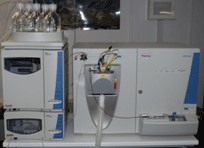
The Team
Dr. Theodora Kalogeropoulou,
Dr. Maria Koufaki,
Dr. Dimitris Papachatzis,
Dr. Ioannis Costas
Where to find us
Location : Institute of Chemical Biology, Vas. Konstantinou 48, Athens 11635
Telephone : +30 210 7273833, -3868
Visit website
